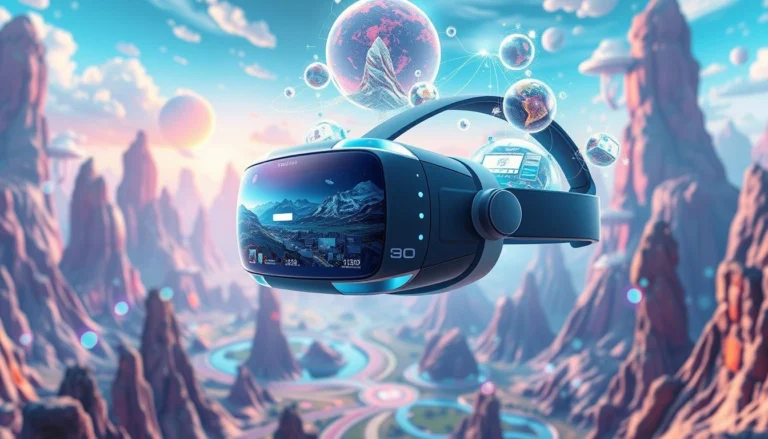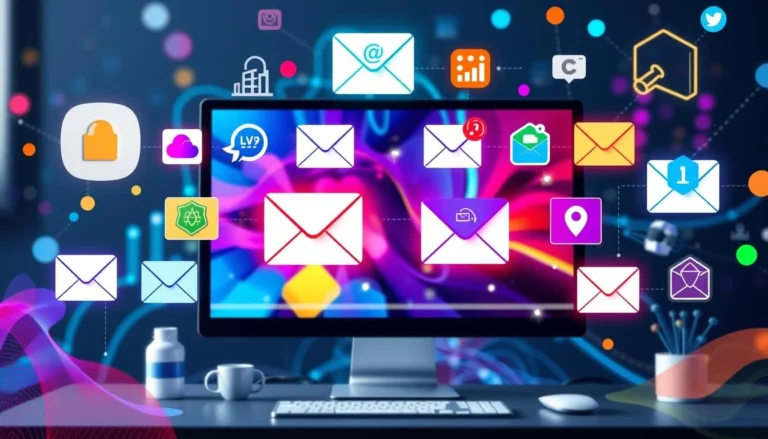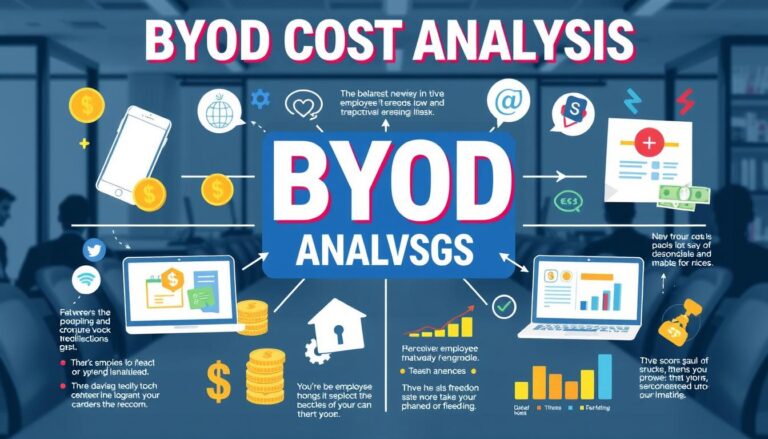2025 Tech Trends Playbook for Business Growth
Navigating Tomorrow’s Landscape: Your 2025 Tech Trends Playbook for Unprecedented Growth
Estimated Reading Time: 15 minutes
Key Takeaways
- Holistic Digital Transformation: Businesses must strategically adopt 2025 tech trends across web, mobile, cloud, and AI for sustained growth and innovation, moving beyond mere tools to fundamental operational shifts.
- AI-Powered Efficiency: AI automation, including advanced chatbots and no-code workflow tools like n8n, is crucial for optimizing business processes, reducing costs, and enabling intelligent delegation, significantly boosting productivity for companies of all sizes.
- Performance-Driven Web & Mobile: Modern web development (Next.js/React, headless CMS) and mobile app innovation (Flutter/React Native) prioritize speed, personalization, and intuitive UI/UX, essential for engaging users and achieving higher conversion rates.
- Agile Cloud Infrastructure: Serverless architecture, robust DevOps practices, and microservices provide scalable, cost-efficient, and resilient foundational infrastructure, enabling rapid deployment and business agility, particularly beneficial for startups.
- Accessibility and Sustainability: Designing for accessibility is a core principle, and the tech industry is increasingly focused on sustainable infrastructure to mitigate the environmental impact of advanced computing, reflecting broader ethical considerations.
Table of Contents
- The Accelerating Pace of Technological Evolution
- Why Understanding 2025 Tech Trends Matters for Your Business
- The Future of Web Development: Smarter, Faster, More Engaging
- Mobile App Innovation: Personalization and Performance in Your Pocket
- Cloud Computing and DevOps: The Foundation of Modern Digital Infrastructure
- AI Automation for Businesses: Intelligent Delegation and Growth
- Digital Transformation Strategies: Empowering Businesses of All Sizes
- Conclusion: Navigating the Tech Horizon of 2025 with AITechScope
- FAQs (Frequently Asked Questions)
- Q1: What are the most impactful tech trends for small businesses in 2025?
- Q2: Should my startup choose Flutter or React Native for mobile app development in 2025?
- Q3: How can AI automation benefit my company beyond simple chatbots?
- Q4: What is serverless architecture and is it truly cost-effective for startups?
- Q5: How can a small team implement effective CI/CD automation?
- Unlock Your Business’s Full Potential with AITechScope
The Accelerating Pace of Technological Evolution
The digital realm is a perpetual motion machine, where yesterday’s breakthroughs become today’s foundations for tomorrow’s innovations. From the ubiquitous reach of artificial intelligence to the foundational shifts in cloud infrastructure, technology continues to reshape industries at an exponential rate. Understanding these underlying currents is crucial for any organization aiming to remain competitive and relevant. The sheer volume of data, the complexity of user expectations, and the demand for instant, seamless experiences are pushing the boundaries of what’s possible, driving a continuous cycle of innovation.
Why Understanding 2025 Tech Trends Matters for Your Business
For businesses of all sizes, from agile startups to established enterprises, comprehending and strategically adopting these 2025 tech trends isn’t optional; it’s fundamental to future-proofing operations and unlocking new opportunities. These trends aren’t just about fancy new tools; they represent fundamental shifts in how products are built, how services are delivered, how customers are engaged, and how internal processes are optimized. Embracing them can lead to significant competitive advantages, including improved operational efficiency, enhanced customer experiences, faster market responsiveness, and entirely new revenue streams. Ignoring them, conversely, risks stagnation and obsolescence in an increasingly digital-first world.
The Future of Web Development: Smarter, Faster, More Engaging
Web development in 2025 is less about static pages and more about dynamic, intelligent, and highly performant experiences. The focus has sharpened on delivering speed, rich interactivity, and deep personalization, all while ensuring robust scalability and maintainability.
Next.js and React: The Performance Powerhouses for 2025
React has long been a cornerstone of modern web development, celebrated for its component-based architecture and declarative UI. However, as user expectations for speed and SEO climb, frameworks like Next.js have emerged as essential companions, supercharging React applications with server-side rendering (SSR), static site generation (SSG), and incremental static regeneration (ISR). This combination delivers blazing-fast page loads and superior SEO performance, critical factors for online visibility and user satisfaction.
Next.js for Small Businesses: Building High-Impact Marketing Sites
For small businesses, the appeal of Next.js extends beyond just performance. It offers a structured yet flexible environment to build “fast marketing sites” in a fraction of the time, often “in one weekend” as one research article suggests. Its built-in optimization features mean less time spent on performance tweaks and more time focusing on content and conversion. The “Next.js small business site” is quickly becoming the benchmark for companies looking to establish a strong, performant, and SEO-friendly online presence without heavy development overhead. For those new to the ecosystem, a “Next.js beginner guide” can quickly onboard teams, enabling rapid deployment and iteration.
Optimizing React Performance: Beyond Basic Practices
While Next.js handles many performance aspects automatically, deep “React performance optimization” remains a vital skill. Beyond basic memoization and lazy loading, 2025 focuses on advanced techniques such as code splitting, efficient data fetching strategies (like React Query or SWR), and leveraging React 18’s concurrent features. Case studies show that “5 simple React performance fixes” can “reduce page load by seconds,” directly impacting user engagement and bounce rates. These optimizations are crucial for complex web applications where every millisecond counts, ultimately leading to a better user experience and higher conversion rates.
The Rise of AI-Powered Web Applications
Artificial intelligence is no longer confined to backend data processing; it’s increasingly woven into the fabric of the front-end, transforming “AI-powered web apps” into intelligent, adaptive interfaces. From personalized content recommendations and dynamic pricing to AI-driven search and predictive user interfaces, AI is making web experiences more intuitive and responsive. Chatbots, powered by advanced NLP, provide immediate support and guidance, while AI analyzes user behavior to optimize layouts and calls to action in real-time. This integration ensures a highly personalized and efficient journey for every user, making the web experience feel truly bespoke.
Headless CMS and WordPress: Flexible Content Delivery
The concept of “headless CMS WordPress” is gaining significant traction, particularly for businesses seeking greater flexibility and omni-channel content delivery. By decoupling the content management backend (WordPress) from the front-end presentation layer (e.g., Next.js, React), businesses can use WordPress’s familiar authoring experience while leveraging modern frameworks for lightning-fast, highly customized front-ends. This approach allows content to be delivered seamlessly across websites, mobile apps, IoT devices, and more, all from a single source. “WordPress without the bloat,” achieved through lightweight plugins and a headless setup, effectively addresses common performance and SEO concerns associated with traditional WordPress implementations.
Modern UI/UX Design: Crafting Intuitive and Responsive Experiences
User Interface (UI) and User Experience (UX) design continue to be paramount. In 2025, the emphasis shifts further towards intuitive, inclusive, and emotionally resonant designs. “Responsive UI design” is a given, but true responsiveness now means adapting not just to screen size, but also to user context, preferences, and even emotional states.
Designing for Accessibility: A Core Principle
Accessibility is moving from a compliance checkbox to a fundamental design principle. “Designing accessible buttons” and indeed, accessible interfaces overall, is recognized as a non-negotiable aspect of good design. Tools like Figma offer features and plugins that empower even “non-designers” to build inclusive interfaces, ensuring that digital products are usable by everyone, regardless of ability. This focus broadens market reach and demonstrates a commitment to ethical design.
Micro Frontends: Modularity in Large-Scale Web Projects
For complex enterprise applications, “Micro Frontends” offer a scalable architectural solution. Similar to microservices on the backend, this approach breaks down a monolithic front-end into smaller, independently deployable units. While they can sometimes “hurt” if not implemented carefully, practical examples show they enable larger teams to work in parallel, reduce deployment risks, and allow for technology diversity within a single application, fostering agility and resilience in large-scale web development.
Mobile App Innovation: Personalization and Performance in Your Pocket
Mobile applications remain central to digital engagement, and 2025 sees them evolving into highly personalized, performant, and context-aware tools that seamlessly integrate into daily life.
Flutter vs. React Native in 2025: Choosing the Right Cross-Platform Framework
The debate between “Flutter vs React Native in 2025” continues, but both frameworks have matured significantly, offering compelling options for cross-platform mobile app development. React Native, leveraging JavaScript/TypeScript and the vast React ecosystem, remains popular for its flexibility and developer familiarity. Flutter, with its Dart language and Google’s backing, provides exceptional performance, beautiful custom UIs, and a fast development cycle.
Building a Cross-Platform App: A Startup’s Guide
For startups, the choice of “which mobile framework for startups” is critical, balancing development speed, cost, and long-term scalability. Flutter often presents a strong case due to its single codebase for iOS and Android, leading to faster development and easier maintenance, potentially allowing a startup to “build a simple cross-platform app… from idea to Play Store” efficiently. React Native also offers rapid development and access to a large talent pool. The best choice ultimately depends on team expertise, specific feature requirements, and performance expectations. Both are excellent choices for modern mobile app development.
Mobile App UI Trends: Immersive and Intuitive Interactions
Mobile app UI trends in 2025 lean heavily into immersive and intuitive interactions. We’re seeing a push towards more gesture-based navigation, haptic feedback, and subtle animations that enhance the user’s tactile and visual experience. Beyond aesthetics, the focus is on predictive interfaces that anticipate user needs, reducing friction and streamlining tasks. This includes integrating augmented reality (AR) for more interactive product views or contextual information, and voice UI for hands-free control, making apps feel less like tools and more like intelligent companions.
The AI-Enhanced Mobile Experience
AI is deeply embedding itself into mobile apps, moving beyond simple recommendations. On-device machine learning enables apps to learn individual user habits, personalize notifications, optimize battery usage, and even enhance camera capabilities in real-time. From intelligent photo editing to predictive text input and personalized health monitoring, the “AI-enhanced mobile experience” makes devices more proactive and responsive to individual needs, transforming mobile apps into highly intelligent personal assistants.
Cloud Computing and DevOps: The Foundation of Modern Digital Infrastructure
The underlying infrastructure of the digital world continues its relentless march towards greater agility, resilience, and cost-efficiency. Cloud computing and DevOps principles are the twin engines driving this transformation.
Serverless Architecture: Cost-Efficiency and Scalability for Startups
“Serverless architecture” is one of the most transformative trends for infrastructure, especially for startups and small businesses. By abstracting away server management, developers can focus purely on writing code (Functions as a Service – FaaS) without worrying about provisioning, scaling, or patching servers. This model inherently offers immense “cost-efficiency and scalability for startups” because you only pay for the compute time your code actually runs.
Serverless on AWS: A Cost-Effective Backend Example
Platforms like AWS Lambda exemplify how “serverless on AWS” can “create a cost-efficient backend that scales automatically.” Instead of maintaining always-on servers, functions are invoked only when needed, handling anything from API requests to data processing. This drastically reduces operational overhead and infrastructure costs, making “serverless backend for startups” an incredibly attractive option for rapid deployment and lean operations. Small businesses can launch complex features without a large IT team.
DevOps Best Practices and CI/CD Automation for Small Teams
DevOps isn’t just for large enterprises; its principles of collaboration, automation, and continuous improvement are critical for “DevOps best practices” in teams of all sizes. Central to this is “CI/CD automation,” which stands for Continuous Integration and Continuous Deployment. For “CI/CD for small teams,” this means automating the build, test, and deployment processes, reducing manual errors, and accelerating the release cycle without the headache of complex setups.
Streamlining Deployments with GitHub Actions
Tools like “GitHub Actions deploy tutorial” offer accessible ways for small teams to implement robust CI/CD pipelines. By defining workflows directly within their code repository, teams can automate everything from running tests on every code commit to automatically deploying changes to production environments. This ensures consistent quality, faster iterations, and frees up developers to focus on innovation rather than repetitive deployment tasks. It’s a cornerstone for agile development.
Cloud Migration Strategies: Moving Your Legacy Apps
Many businesses still grapple with legacy applications, but 2025 underscores the urgency and benefits of cloud migration. A well-planned “cloud migration strategy” involves assessing existing infrastructure, choosing the right cloud services (IaaS, PaaS, SaaS), and executing a phased migration. The goal is to move “your legacy app to the cloud without breaking it,” unlocking scalability, resilience, and cost savings while modernizing the tech stack. This often involves containerization (e.g., Docker, Kubernetes) and refactoring specific components to be cloud-native.
Microservices Architecture: Agility and Resilience
Complementing cloud and DevOps is “microservices architecture.” This approach structures an application as a collection of loosely coupled, independently deployable services, each responsible for a specific business capability. While it introduces complexity, it offers unparalleled agility, allowing individual services to be developed, deployed, and scaled independently. This enhances resilience, as the failure of one service doesn’t necessarily bring down the entire application, and enables teams to choose the “tech stack for modern businesses” at a granular level for each service, promoting innovation.
AI Automation for Businesses: Intelligent Delegation and Growth
Perhaps no trend holds as much transformative power as artificial intelligence and its application in automation. From automating repetitive tasks to providing strategic insights, AI is fundamentally changing how businesses operate. AITechScope, with its specialization in AI-powered automation, n8n workflow development, and business process optimization, is at the forefront of this revolution.
Chatbot Automation: Enhancing Customer Service and Efficiency
“Chatbot automation” has moved far beyond rudimentary scripts. In 2025, AI-powered chatbots, leveraging advanced natural language processing (NLP) and machine learning, are becoming sophisticated virtual assistants capable of understanding complex queries, providing personalized responses, and even performing transactions. They are revolutionizing customer service, offering 24/7 support, reducing response times, and handling routine inquiries, allowing human agents to focus on more complex issues.
Real-World Chatbot Workflows for Small Businesses
For “small businesses [that] use chatbots to save time,” the benefits are immense. “Real workflows that work” include automated lead qualification, FAQ resolution, appointment scheduling, and even basic technical support. These chatbots can integrate with CRM systems, marketing platforms, and internal tools, creating seamless customer journeys and significantly reducing operational costs. They provide an immediate, accessible point of contact, enhancing customer satisfaction and boosting efficiency.
Workflow Automation Tools: Saving Time with No-Code + AI
The synergy between “no-code tools + AI” is unlocking unprecedented levels of “workflow automation.” Platforms like n8n (AITechScope’s specialty!), Zapier, Make, and UiPath enable businesses to connect disparate applications and automate complex multi-step processes without writing a single line of code. This empowers business users, not just developers, to create sophisticated automation flows. Automating repetitive tasks with these tools can “save 5–10 hours/week” per employee, translating into significant productivity gains and allowing teams to focus on higher-value activities. AITechScope helps businesses implement these intelligent delegation solutions to optimize their operations.
AI in SaaS Products: Delightful Features, Low Effort
SaaS providers are integrating AI to make their products “smarter” and more user-friendly. “3 low-effort AI features that delight users” can include predictive analytics for business intelligence, smart recommendations for content or products, and AI-driven personalization of user interfaces. These features enhance the value proposition of SaaS products, improve user engagement, and create a more intelligent, adaptive experience without requiring extensive development efforts from the SaaS vendor. It’s about making software smarter behind the scenes to simplify the user’s journey.
Enterprise Digital Adoption and AI-Powered Decision Making
For enterprises, AI is a critical driver of “digital adoption strategies” and decision-making. AI algorithms can process vast amounts of data, identifying patterns, predicting future trends, and offering prescriptive insights that human analysis might miss. This leads to more informed strategic planning, optimized resource allocation, and proactive risk management. From supply chain optimization to personalized marketing campaigns, AI empowers businesses to make data-driven decisions at speed and scale, fostering true “enterprise digital adoption.”
The Broader AI Landscape: From Audiobooks to Smart Glasses
The year 2025 also showcases some fascinating, broader applications of AI that will reshape how we interact with technology and consume content.
ElevenLabs and AI-Generated Content
Voice AI company ElevenLabs is making waves by allowing authors to “create and publish audiobooks on its own platform,” including AI-generated narrations. This innovation, following a partnership with Spotify, democratizes audiobook creation, making it more accessible and cost-effective. It highlights the growing potential of AI in content generation, offering new avenues for creators and publishers, and potentially making diverse voices (even AI-simulated) more available. This significantly impacts accessibility and the speed of content production.
The Future of AI Hardware: Always-On Devices
The concept of “always-on AI smart glasses that listen and record every conversation” points to a future where AI is deeply embedded in our physical environments. While raising significant ethical and privacy concerns, these devices, developed by former Harvard students, represent a leap in pervasive AI. They aim to provide real-time information, context-aware assistance, and memory augmentation, promising a truly connected and “intelligent” daily experience, albeit with challenges that society will need to address.
AI and Sustainable Infrastructure (Meta’s solar investment)
Even large tech companies like Meta are recognizing the energy demands of their AI infrastructure. Meta’s commitment to “add 100MW of solar power from US gear” to power new AI data centers in South Carolina underscores a growing trend. As AI models become more complex and data centers expand, the industry is increasingly focused on sustainable energy solutions to mitigate the environmental impact of advanced computing, integrating AI development with environmental responsibility.
Strategic AI Use for CEOs
Beyond automation, CEOs are finding “5 bold ways I use AI” for strategic leadership. This includes using AI for scenario planning, identifying market opportunities, understanding competitive landscapes, optimizing organizational structures, and fostering innovation culture. AI is becoming a co-pilot for high-level decision-making, helping leaders navigate complexity and drive strategic outcomes, demonstrating AI’s value far beyond just task delegation.
Digital Transformation Strategies: Empowering Businesses of All Sizes
Digital transformation is not a one-time project but an ongoing journey, and in 2025, it’s more accessible and crucial than ever for businesses of every scale.
Digital Transformation on a Budget: A Roadmap for Small Companies
Many small companies believe digital transformation is too costly or complex. However, “Digital Transformation on a Budget: 7 Steps Small Companies Can Start Today” demonstrates that it’s achievable through strategic, incremental changes. This includes prioritizing cloud adoption, leveraging cost-effective SaaS solutions, automating repetitive tasks (where AITechScope excels!), enhancing cybersecurity, and adopting data-driven decision-making. It’s about identifying quick wins and building momentum rather than undertaking a massive overhaul.
Tech Innovation for Small Businesses: Leveraging Modern Stacks
Small businesses no longer need to compromise on technology. The availability of powerful, scalable, and affordable tools means “tech innovation for small businesses” is a reality. Leveraging modern stacks, such as Next.js for front-end, serverless functions for backend, and intelligent automation tools like n8n, allows small businesses to compete effectively with larger enterprises. These technologies provide agility, reduce time-to-market, and offer a robust foundation for growth without requiring huge upfront investments in infrastructure or personnel.
Performance Optimization Techniques Across the Stack
In 2025, performance is a critical differentiator. “Performance optimization techniques” are applied “across the stack,” from the database to the front-end. This includes optimizing database queries, implementing caching strategies, utilizing CDNs, streamlining serverless functions, and applying front-end best practices like image optimization and code splitting. “Real-World Case Study: How We Cut Page Load by 60% for a Client” exemplifies the tangible benefits of a holistic approach to performance, directly impacting user experience, SEO rankings, and conversion rates.
The Modern Tech Stack for Business Agility
The “tech stack for modern businesses” in 2025 is characterized by flexibility, scalability, and interoperability. It’s a mosaic of best-of-breed solutions rather than a monolithic suite. This often includes:
- Front-end: Next.js/React or Flutter/React Native for web and mobile.
- Backend: Serverless functions (AWS Lambda, Azure Functions, Google Cloud Functions) or microservices running on containers (Docker, Kubernetes).
- Database: Cloud-native options like DynamoDB, Aurora, or fully managed SQL databases.
- CMS: Headless CMS (e.g., Strapi, Contentful, or headless WordPress).
- DevOps: CI/CD pipelines (GitHub Actions, GitLab CI/CD) for automated deployments.
- Automation: AI-powered workflow tools like n8n, Zapier for business process optimization.
- AI/ML: Integrated services for data analytics, personalization, and intelligent automation.
This modern stack enables businesses to be agile, experiment rapidly, and scale efficiently in response to market demands.
Conclusion: Navigating the Tech Horizon of 2025 with AITechScope
The year 2025 stands as a pivotal moment in the ongoing digital revolution. The convergence of advanced web development frameworks, innovative mobile app technologies, resilient cloud and DevOps practices, and pervasive AI automation is creating an ecosystem ripe with opportunities for businesses ready to embrace change. From optimizing web performance with Next.js to harnessing the power of serverless backends and intelligent chatbots, the tools for unprecedented growth and efficiency are at our fingertips.
Understanding these “2025 tech trends” isn’t enough; strategic adoption is key. This is where AITechScope becomes your invaluable partner. As specialists in AI-powered automation, n8n workflow development, and business process optimization, we empower businesses to intelligently delegate, streamline operations, and unlock significant cost savings. Whether you’re a startup seeking a lean, scalable infrastructure or an established enterprise aiming for comprehensive digital transformation, AITechScope provides the expertise and solutions to help you navigate this exciting tech horizon. Embrace the future, transform your operations, and accelerate your growth by leveraging the power of 2025’s leading technologies.
FAQs (Frequently Asked Questions)
Q1: What are the most impactful tech trends for small businesses in 2025?
A1: For small businesses, the most impactful trends include adopting Next.js for fast, SEO-optimized marketing sites, leveraging serverless architecture for cost-efficient and scalable backends, implementing AI-powered chatbots for customer service, and utilizing workflow automation tools like n8n to reduce manual tasks. These empower small businesses to achieve significant digital transformation on a budget.
Q2: Should my startup choose Flutter or React Native for mobile app development in 2025?
A2: Both Flutter and React Native are excellent choices for startups aiming for cross-platform mobile apps. Flutter often offers superior UI performance and a faster development cycle with a single codebase, ideal for quick market entry. React Native leverages JavaScript, which might be advantageous if your team already has web development expertise. The best choice depends on your team’s existing skill set, specific UI/UX requirements, and long-term maintenance strategy.
Q3: How can AI automation benefit my company beyond simple chatbots?
A3: Beyond chatbots, AI automation can dramatically benefit your company by powering intelligent workflow automation (e.g., using n8n to connect systems and automate complex processes), providing predictive analytics for data-driven decision-making, personalizing user experiences in web and mobile apps, and optimizing internal operations from supply chain management to HR. Strategic AI use can also aid CEOs in market analysis and scenario planning.
Q4: What is serverless architecture and is it truly cost-effective for startups?
A4: Serverless architecture is a cloud execution model where the cloud provider dynamically manages the allocation and provisioning of servers. You only pay for the exact compute resources consumed when your code runs, rather than paying for always-on servers. This model is exceptionally cost-effective for startups because it eliminates idle server costs, scales automatically to meet demand, and significantly reduces operational overhead, allowing you to focus resources on development and innovation.
Q5: How can a small team implement effective CI/CD automation?
A5: Small teams can implement effective CI/CD automation by leveraging cloud-native tools and platform features. GitHub Actions is an excellent example, allowing teams to define automated workflows directly within their code repositories. This enables automated testing, building, and deploying of applications with every code commit, reducing manual errors, speeding up release cycles, and enhancing overall software quality without requiring extensive DevOps expertise or infrastructure.
Unlock Your Business’s Full Potential with AITechScope
The future is here, and it’s powered by intelligence, efficiency, and innovation. Don’t let the complexity of 2025’s tech trends hold your business back. AITechScope is your dedicated partner in harnessing the power of AI-powered automation, n8n workflow development, and intelligent business process optimization.
Ready to transform your operations, accelerate growth, and lead the way in your industry?
Contact AITechScope today for a personalized consultation and discover how we can help you integrate cutting-edge AI and automation solutions to scale your business, reduce costs, and thrive in the digital future.







